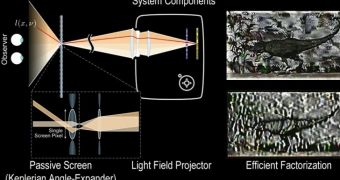3D displays haven't become ubiquitous, but they're not a novelty anymore either, and while TVs make do without the capability more often than not, films still get shot in that format, and cinemas use 3D projectors a lot now. MIT is taking things to the next level.
And it's not concerning itself with films or, really, entertainment as a whole. Instead, MIT wants to provide the best thing next to holographic technology.
You must have seen it in a half dozen movies by now, a holographic user interface that the one can manipulate just by reaching out and grabbing it.
We've seen it in the Iron Man movies, Ender's Game, and we'll soon see it in Transformer 4: Age of Extinction.
Unfortunately, real-life technology isn't at the stage where such an interface is possible, at least not that we know of.
So a team of researchers from MIT, the Camera Culture group at the MIT Media Lab to be specific, have come up with an alternative.
Or, rather, they've invented a technology that can fill in until holographic interfaces spanning entire rooms become real.
Their idea is for a 3D video projection system that doesn't need you to wear a pair of glasses in order to see an object as if it were real, physical.
The key to their invention (or soon-to-be invention, since it's still in developing stages) was to provide a wide vision angle and ultra resolution, while keeping things simple and free of reliance on complex equipment.
As a transitional technology, it will be a short-term stepping stone until actual holographic technology is created.
The MIT system creates an actual shift in perspective for more than one viewer, instead of painting an illusion of depth. Resolution and contrast should be superior to 2D videos too.
Two flat panels of liquid crystal modulators are the core of the system, essentially a pair of LCDs between the backlight source and the lens. The first LCD produces the light patterns at certain angles, and the pattern passes through the second bank only at those angles. The light beam passes through a series of lenses and, finally, a transparent projection screen made of lines of vertical lenses.The resulting image shifts as you move from one position in front of the projection to another. It's like looking at one of those children's toys, books or cards that change image when you shift it in your hand.
All the while, the refresh rate stays at a solid 240 times per second (10x better than standard-speed film, if inferior to TVs) and can handle UHD video if needed. Applications in everything from entertainment to medical imaging are being considered.

 14 DAY TRIAL //
14 DAY TRIAL // 


